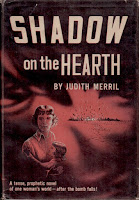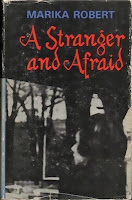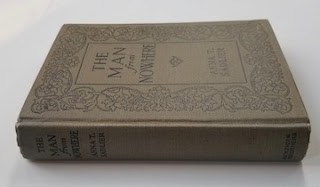Not for Every Eye [Le libraire]
Gérard Bessette [trans. Glen Shortliffe]
Toronto: Macmillan, 1962
98 pages
Yesterday marked the centenary of Gérard Bessette's birth. I spent an hour or so reading this translation of his most celebrated work. A novella – not a novel, as Macmillan claims – it isn't very long.
Bessette's title,
Le libraire (The Bookseller), refers to narrator and protagonist Hervé Jodoin. It takes the form of a journal written on Sundays, when the bars are closed. The first entry involves Jodoin's arrival in the fictional Quebec town of Saint Joachim, where he has accepted a job in a bookstore. In truth, it's as much a bookstore as, say, Indigo; the better part of the establishment has been given over to toys, stationary, and religious articles. The book department is in the rear, allowing Jodoin to pass a good portion of the day in a quiet snooze.
Killing time is Jodoin's main occupation. He quickly settles into a routine – "book shop, beer parlour, room; room, book shop, beer parlour." At the end of each workday, he heads for Chez Treffelé, a working class bar where he drinks alone at a table located conveniently near the lavatory. After that – meaning, after the bar closes – Jodoin makes for his rooming house bed.
A crack appears in what Jodoin describes as "the monotony of my life" when the store's proprietor, Léon Chicoine, determines that his new bookseller is a believer in liberty and is a proponent of free thought. Chicoine unlocks a door to what Jodoin had thought was a closet, revealing the
"sanctum sanctorum," a small, windowless room lined with books found in the
Index Librorum Prohibitorum, and listed by
Abbé Bethléem and Père Georges Sagehomme.*
Chicoine demands Jodoin's discretion, and asks him to sell the volumes (at inflated prices) to "serious purchasers." Our hero agrees, and starts off for Chez Treffelé "caressing the innocent notion that perhaps after all I was not yet completely useless, that perhaps my life might have a meaning."
Sadly, Jodoin's new customers fail to give meaning to his life:
They sidle up to me with a conspiratorial air and murmur into my ear the name of some author or book, all this in the same tone of someone asking for a condom or a suppository in a drug store. Others are more evasive still; they shower me with meaningful glances and ask me to recommend "something a little out of the ordinary" or "something with a kick to it."
Jodoin quickly comes to resent the extra work involved in retrieving volumes from the
sanctum sanctorum, recognizing most aren't at all interested in liberty and freedom of thought: "If these jokers are looking for an aphrodisiac, they can find more effective ones."
The crack widens and drama begins with a pimply-faced boy he recognizes as a student of the Saint Roch School, "located a couple of miles from the town in open country, in the middle of a vast domain belonging to a community of clerics who combine the dairy industry with the rearing of young men." The student asks for a volume by Voltaire, and whether "through curiosity or a kind of fellow-feeling produced by nostalgia for my own school days," Jodoin retrieves a copy from the
sanctum sanctorum.
Le libraire was first published in Paris because Bessette was unable to find a Quebec publisher. This was in 1960, mere months before the Quiet Revolution began. Within two years, the novel had found a Quebec publisher, and had been translated and published in English.
I received this copy of
Not for Every Eye as a gift on my twenty-third birthday. I read it the very same summer. A university student at the time, I used its story, and the story of its publication, in writing papers on the Quiet Revolution.
Much of the revolution took place when I was asleep in a crib.
I have people like Gérard Bessette to thank that it did.
* Researching this piece, I was amused to discover that Georges Sagehomme's Répertoire alphabétique de plus de 7000 auteurs avec leurs ouvrages au nombre de 32000 (romans et pièces de théâtre) qualifiés quant à leur valeur morale (1931), was revised nine times; the last – published twenty-nine years after his death – is Répertoire alphabétique de 16700 auteurs 70000 romans et pièces de théâtre cotés au point de vue moral.
Trivia: There is an actual St-Joachim, Quebec, located roughly thirty kilometres downriver from Quebec City, but it bears no resemblance to the town depicted in Bessette's novel.
More trivia: Adapted by M. Charles Cohen for CBC Television (1963) and CBC Radio (1967). The former starred Jack Creley, Larry Mann, and Barbara Hamilton.
Object: A slim volume consisting of white boards with purple type, as an
objet Not for Every Eye is my favourite Macmillan of Canada book. Credit goes to
Leslie Smart.
Arnaud Maggs designed the jacket.
Bibliophiles will appreciate the adverts for other Macmillan titles on the back cover. I own three, but have read only one.
Access: The translation may be neglected, but it is not rare. Very Good copies are offered online for as little as ten dollars. I've seen some evidence of a softcover edition that may have been a rebind. It would seem that in 1977 the novella was absorbed into Macmillan's moribund Laurentian Library, though I've yet to encounter a copy. I have, however, seen the 1984 edition, issued by Exile (right). It is still available for purchase.
A second English translation, which I've not read, was published in 1999 by Guernica Editions. Its translator, Steven Urquhart has written a very interesting essay about the need and process:
Retranslating a Quebec Classic
The Urquhart translation is also still in print.
Remarkably, there is a Czech translation,
Skandal V Knihkpectvi (Scandal in the Bookstore; Prague: Odeon, 1974). Collectors may be interested in a copy inscribed to Bessette by translator Ea Masnerova on offer from an Oregon bookseller.
Copies of
Le libraire are plentiful. The cheapest copy I've seen offered online is going for one Yankee dollar. Few copies of the first edition, published in Paris by Jilliard, are in evidence.































